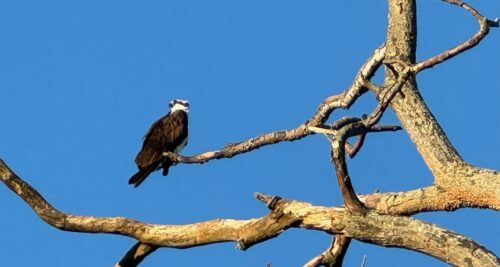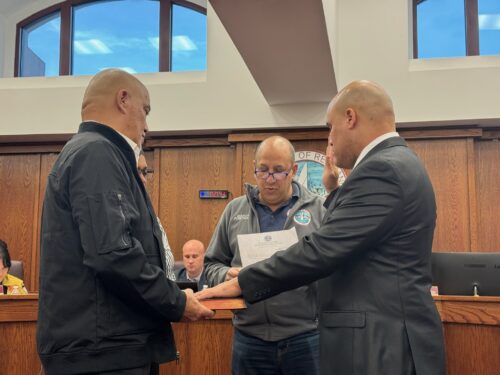A dolphin in the Shrewsbury River in November.
Federal marine life authorities say only five of the original 16 Atlantic bottlenose dolphins that set up house in inland waters here last June remain, and that more are likely to die.
One dolphin has died and six others are unaccounted for since Dec. 17, when a team of scientists assembled by the National Oceanic and Atmospheric Administration restated their collective belief that the animals could survive the winter in the Navesink and Shrewsbury Rivers.
The remaining animals appear to have lost weight in recent weeks, NOAA reported yesterday. Still, the agency is holding off on any interventions to drive, lure or relocate the dolphins to the open sea, where they might follow their traditional winter migration toward the waters off North Carolina.
From the NOAA announcement:
NOAA expects additional mortalities or live strandings among
the remaining animals may occur as the winter progresses. We also
continue to believe that these animals are not candidates for
intervention and relocation. We are working with members of the
Northeast Stranding Network as well as other private marine mammal and
wildlife conservation organizations to strengthen emergency stranding
response in the area in the event that a stranding occurs.
NOAA says all of the five remaining dolphins are in the Shrewsbury River and none have been spotted in the Navesink since late December. That would put them nearer to the gateway to Sandy Hook Bay.
For months, critics have pushed for NOAA to take steps to shepherd the pod through the strait, which is beneath the Highlands-Sea Bright Route 36 bridge, which is being demolished and replaced. NOAA contends interventions efforts are unlikely to work and could kill dolphins in the process.
Here's the full NOAA announcement from spokeswoman Teri Frady:
NOAA observation surveys of the bottlenose dolphins still residing in
the Shrewsbury-Navesink Rivers during late December and early January
confirm that five live animals are still present in the Shrewsbury
River. None are believed to be in the Navesink. The three surveys
conducted since Dec 15 have also documented weight loss in some
individuals.
Of the 12 animals present at the beginning of December, one was
confirmed dead and recovered on Dec 25, six were resighted during the
surveys conducted Dec 29 and 30, and five of those six resighted on Jan
5 and 6. The whereabouts and condition of six of the twelve are unknown
as of Jan 6. No carcasses have been reported or found since that
discovered on Dec 25.
Of the original 16 animals documented in June 2008, 3 are confirmed
dead, the whereabouts and condition of 8 are unknown, and 5 remain in
Shrewsbury River as of January 6. One animal was sighted in the Navesink
River Dec 29 & 30, and none in January.
By examining photographs and written observations from the December
surveys, NOAA dolphin researchers documented weight loss or possible
weight loss in 8 of 12 individuals present at the beginning of the month.
· Of the 8 individuals exhibiting weight loss or possible weight loss,
one was confirmed dead December 25, three were resighted Jan 5 or 6, and
four were not.
· The animal found dead on December 25 was sent for necropsy, which
confirmed it to be an adult female carrying a third trimester fetus.
There were old lesions on the adults lungs and no stomach contents.
Tissues and the entire head of the adult, as well as the fetus, are
being examined further for signs of illness, injury, abnormalities, or
conditions that contributed to the death. Analysis of the head should
help establish the age and confirm the specific subpopulation of the adult.
Prospects: NOAA expects additional mortalities or live strandings among
the remaining animals may occur as the winter progresses. We also
continue to believe that these animals are not candidates for
intervention and relocation. We are working with members of the
Northeast Stranding Network as well as other private marine mammal and
wildlife conservation organizations to strengthen emergency stranding
response in the area in the event that a stranding occurs. NOAA is
planning a second seminar on the dolphins at Monmouth University on
January 13, 2009, details to follow.
Our website has been updated with sighting photographs for December and
January, and revised FAQs reflecting the changing conditions of the
dolphins: www.nefsc.noaa.gov/njdolphins/






















